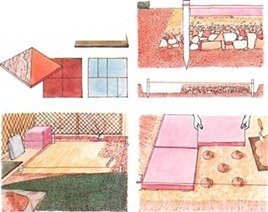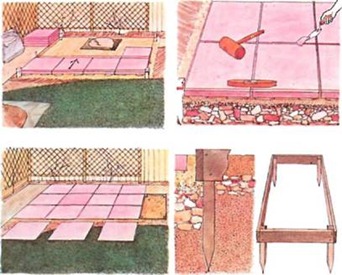





We devote the bulk of Stage 7 to finishing your patio. It seems a shame having started not to keep on going and get it finished. If you’re a warm weather gardener, you need to do it now because cold weather will deter you later. In parts of the US you freeze solid in winter you’ve little option. In the UK and in mild winter zones of the US you could leave this till mid winter, when the plants are making the least demands on you.
Needs list: 15 pre-cast concrete paving slabs; 1 bag cement/sand mix; 4 lengths used board 4 in by 1-½ in; four 15 in stakes; 2 transplants each of the herbs you want.
Time budget: 7 hours in 2 weeks
High air and soil temperatures keep plants growing well. High air temperatures cause the plants to draw heavily on soil-water reserves so keep the hose sprinkling in hot, dry weather. Summer vacation can wreck your gardening schedule, so plan with a neighbour to see to essentials.
This fortnight’s gaily coloured flower is probably known to you as a geranium. It’s not a geranium. A geranium is something else again. It’s a pelargonium. Ask for a geranium and you might just get the wrong plant. Pelargoniums are a huge group of sun-loving South Africans. The flowers come in colours from white through pinks to scarlet, crimson, mauve and dusky blacks. The leaves are almost as varied, sometimes just with a brown stripe, often with concentric rings of red, yellow, green, white and brown. Some creep, crawl, climb or sprawl. All are delightful, all ways, always. Ideal for tubs, pots, hanging baskets, troughs, sinks and so on. Ask your garden centre for advice on varieties.
1. Remove dead heads of annuals to extend flowering season.
2. Continue to mow lawn regularly: most people mow once a week; keen gardeners twice a week; fanatics three times a week. Continue to dig out large weeds as in Stage 5.
3. Check compost bin for continuing decomposition of vegetable matter. Sprinkle a layer of commercial activator on top if you don’t seem to be getting results.
4. Moisture conservation: very important. Hoe top 1 in. of soil to make a ‘blanket’ of fine soil particles. Leave hoed weeds on ground as a green mulch.
5. Keep newly planted bedding plants moist. Alternative bedding plants include petunias, ageratum, tagetes, salvia, coleus, trailing nepeta, pansy and French marigold.
6. Friends and foes. Ants are enemies. They ‘farm’ aphids for their ‘honey’. Sprinkle sugar, watch ants carry it to their nest, then destroy nest with boiling water. Centipedes are friends: they eat many troublesome bugs. Don’t jump on them just because they look as though they might be a pest. There are enough real pests to jump on as it is.

If you want to press on with your patio, here’s how to go about it. It’s fun to get it finished at this time of year – you can use it right away. Choose paving materials to suit your home. We’ve chosen 2 ft. by 2 ft. non-slip pre-cast concrete paving slabs. We lay ours four square. The patio area (Stage 6) should now be extended to 8 ft. by 6 ft. to take 12 slabs. Do your own sums for your own materials. Use stakes, string, boards and spirit level to check patio level. Allow slight slope so water drains away from house: allow a fall of 1/2 in. in 6 ft. Fill and firm any hollows in hard core. Rake layer of builder’s sand level (allowing for fall). Allow for thickness of paving slabs when lining levels up with existing paths up to about 2-1/2 in.

Mix cement/sand and lay 5 dollops for each slab – one under each corner, one under middle. Position slab on cement. Tamp down. Check levels two ways with spirit level. Lay slabs row by row. Leave 1/2 in. between slabs. Fill later with strong cement/ sand mix. Rake out footmarks and re-level sand before laying next row. Complete laying slabs.
A week later fill gaps between slabs. Add finishing touch. Lay 3 slabs in the lawn. Set them in the lawn as described in Stage 10. Then the mower will go over them easily. Next make your herb garden. Make a board frame as illustrated. Fix size to suit your garden. Creosote wood. Fix extra boards across middle to make a compartmented herb garden if you want: helps control runaway herbs like mint. Place in position.
Save money: use patio levelling stakes as corner stakes for herb garden. Once frame is in position, place a 3 in. drainage layer across the bottom. Fill frame with soilless growing mix. Firm. Leave to settle. Do not plant your herbs till the spring. Buy pot-grown plants or grow from seed sown in peat pots indoors during the winter months. Alternatively root cuttings of shrubby herbs in late summer to overwinter indoors.
Two Hour Gardening Project: Stage 26 Climbing Plants and Pergolas
Two Hour Gardening Project: Stage 25 Getting To Know Your Garden
Two Hour Gardening Project: Stage 24 Propagation and Growing Herbs
Two Hour Gardening Project: Stage 21 Making Christmas Present Plants
Two Hour Gardening Project: Stage 20 Tubs and Container Gardening
Two Hour Gardening Project: Stage 18 Choosing Shrubs for the Garden
Two Hour Gardening Project: Stage 17 Fan Trained Fruit Trees
Copyright © www.100flowers.win Botanic Garden All Rights Reserved